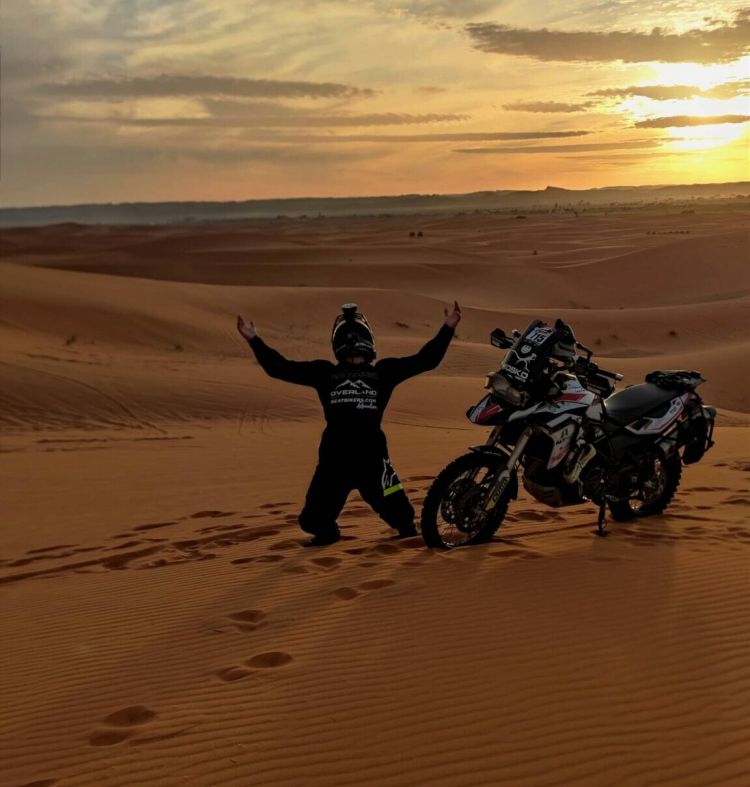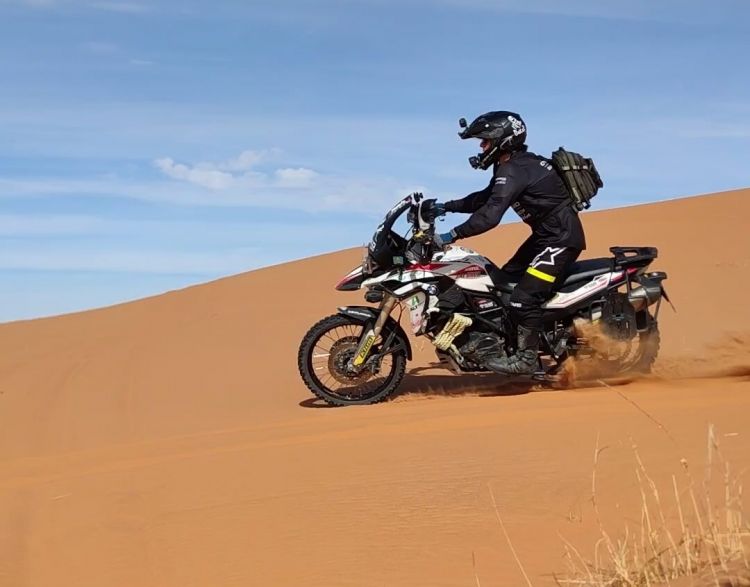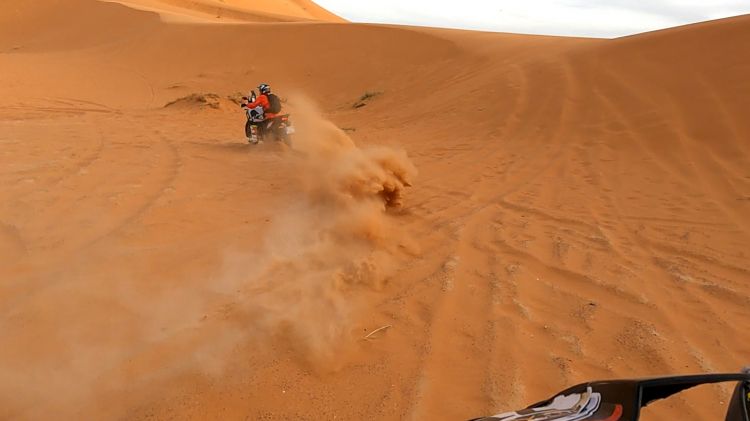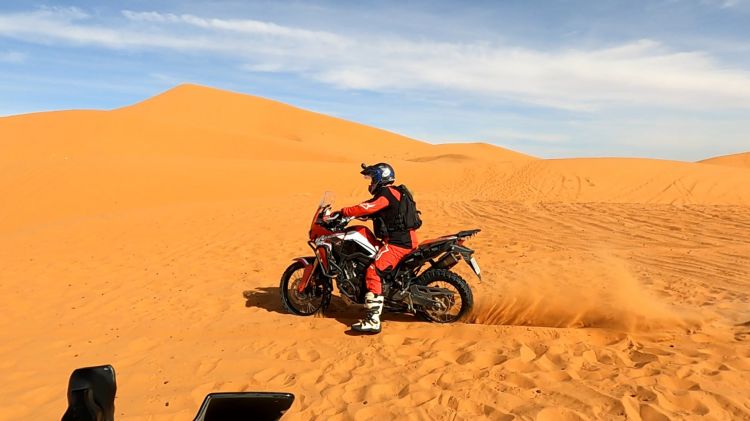The Dakar 2023 is approaching and the spirits are heating up, it is the time in which many trail bike owners feel the spirit of adventure closerFurthermore, with the rise of this type of motorcycle every time it is more common to see authentic hordes of them in the Erg Chebby area.
Today I want to talk about this topic because I have recently been there and I have been able to see first-hand many people trying to access them without success. Suffering physically and making the bike suffer by taking it to the rev limit in first gear for a long time. Therefore, I would like to dedicate these words to explain a little what it takes to enjoy this wonderful environment for both motorcyclists and drivers of 4X4 and SidebySide.
The motorcycle.
The first and most important thing is know that a Trail motorcycle can navigate the dunes with relative ease, we have to be clear about that since the question of whether the bike is capable of doing it or not is the first thing we can come to feel. Once we are clear that motorcycles like the BMW F 800/850 GS, the Yamaha Ténéré 700, Honda Africa Twin and the like (basically Trail bikes around 200/240Kg with a 21-inch front tire and a displacement of 600/800cc) They are grateful motorcycles with this terrainContrary to what many may imagine.
And because? Well, because although its weight plays against it a bit if we compare them with light enduro bikes, these Trail bikes have plenty of power to make us float on the sand, and that is the kit of the question. Float up.
In order to ride as efficiently as possible in the fine desert sand, it is It is very important to fit our motorcycle with appropriate wheels, I’ve seen a lot of people ride mixed wheels and try vehemently and get rather little. This is by no means to say that it is impossible with these wheels, but with them it is necessary to already have previous experience and to know what to do. Nail stud wheels like the MotoZ Tractionator Desert or similar from other brands would be ideal so that our bike has the necessary traction to push us through the sea of sand. Apart from the fact that the tire has good studs, it is very important to play with the pressures.
Normally we are used to having pressures between 1.5bar and 2.0bar when we do offroading in Europe. These pressures may be adequate for hard terrain, but in mud and sand there is more to pull down. In my particular case to ride comfortably in the desert I have around 0.5bar of pressure on both wheels, this may seem crazy since on hard ground it would be to make sure the tire breaks or in case of having an inner tube, to turn the tire with respect to the rim and tear off the valve (causing total loss of air) But in that type of terrain it is very difficult for this to happen since it is a very smooth terrain and without rocks. In order to heal myself, I have mounted cover brakes on my tires, making it more difficult for that to happen with such low pressures.
Having these two things under control, tire and tire pressure, the bike is ready to face a day of dunes. But what about the pilot?
The pilot.
It is clear that in order to do this the pilot has to have some offroad backgroundWe have already seen some videos of professionals with Trail and MaxiTrail motorcycles who go without sweating a drop through the large dunes. Here a maxim comes into play, the slower you go, the more you get tired and the more difficult it is. This requires further explanation, since you can mistakenly understand that you have to go very fast, and no, it’s not that. What it means is that, just like airplanes, they need a certain speed to acquire lift and thus be able to fly. our motorcycle in the sand needs a speed of about 40/50 km/h to be able to start floating right on the sand.
Once we reach that speed (which usually coincides with going in second gear at medium/high speed) we realize that everything becomes easier, the bike is much more stable and we don’t need to fight every meter. The ideal way to acquire this type of technique and be able to go calmly and enjoying it is to take a specific offroad course. There are many companies dedicated to it like Overland Experiencebased in Madrid.
The technique.
As everything in life, having the proper technique is essential for dune makingIt requires many hours of practice to do it like a Pro, but there are some things we can do to be able to get in and out (getting out is the important thing…) of the spectacular Merzouga desert (or any other nearby dune area, of which there are many).
We are going to put ourselves in the situation of being with our Trail or MaxiTrail already in the sand, the first thing we have to do is start walking, for this I have seen that each maestrillo has his booklet, there are those who think that it has to go out in second directly, and those like me, think that our motorcycles in first gear already come out like a shot since the developments of the marches are oriented to the road.
Thus, I personally usually alternate between starting first or second, depending on the situation. I would tell a first-timer to go out in first gear, since a very common mistake to see is constantly stalling the engine due to not giving enough throttle or giving it correctly. But if, start second in loose sand if it is done well it is better (repeating the “if done well”)
If we are already underway, we have reached the float speed, to help that float the ideal is to put the weight back a little to free the front wheelWe can achieve this if we are standing up and well supported against the motorcycle with our knees. Going straight is really easy, you just have to carry that certain speed, the intricacy comes when we want to turn, and in the desert, you have to turn a lot. The ideal is stand up before braking, brake by cutting the gas or with the rear brakealways avoid that we can use the striker. During the curve we sit down to emphasize even more the sending of weight to the rear wheel and free more the front, once we have passed the axis of the curve that we have mentally set ourselves to do, we open up the gas and stand up.
There are many more details, such as take very hard suspension compression for example, that they will help us to end up riding very well on this terrain, but we leave that to show on site.
In summary and responding to the question in the title, no, it is not crazy to put a Trail motorcycle in the dunes, what is a bit crazy is to do it without having previous experience. In Spain there are certain sandy areas that, despite being different in the thickness of the grain of the sand, are ideal for learning and training. Practicing on them will give us a small base that will allow a very comfortable transition to the desert sand of dunes.




